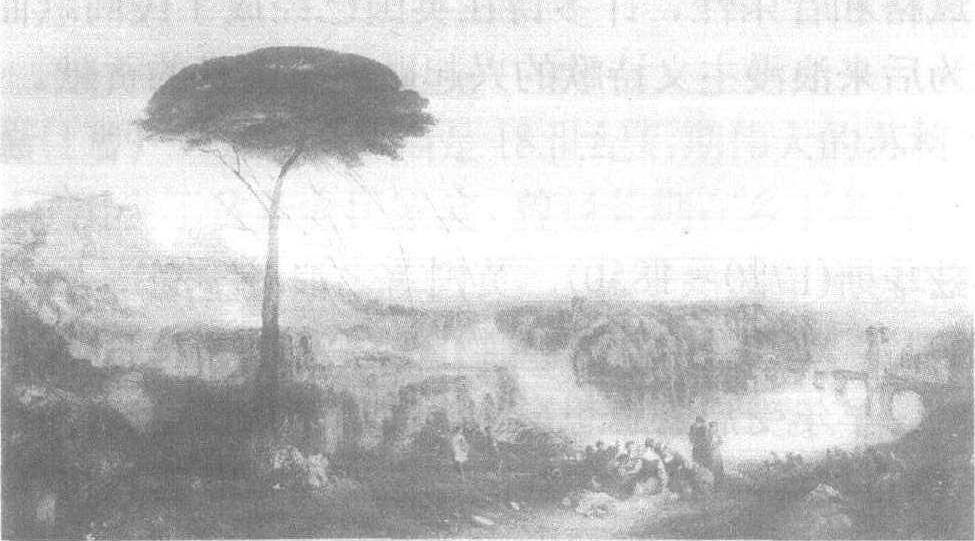拜伦1788—1824Bailun,George Gordon Byron
英国诗人。后期浪漫主义的杰出代表。出生在破落的贵族家庭,早年求学时代受到启蒙思想的熏陶,成年后接触了当时欧洲各国的民主运动,他形成了反对专制压迫,支持人民革命的思想,并积极参予了争取民主自由、民族解放的伟大斗争。
《恰尔德·哈洛尔德游记》(1812~1818)是诗人第一部重要的作品。1812年前两章发表时震动了欧洲文坛。主人公恰尔德是一个具有叛逆性格的贵族青年,他深深地热爱祖国,但却厌恶周围空虚无聊的现实,他孤高自傲。忧郁寡欢,他的性格使他与庸俗、虚伪的上流社会格格不入,而他的贵族习气又使他无法接近下层人民,于是他愤然出国,到海外寻求解脱,开始漂泊的生活。长诗通过恰尔德和诗人自己的浪漫抒情和见闻,表现对拿破仑的侵略、英国于涉民族独立运动等各种暴政的愤慨;对莱茵河、阿尔卑斯山等自然景色的喜爱;对意大利建筑和雕刻等艺术美的欣赏;对卢梭、伏尔泰等具有先进思想的人的敬仰;对反对压迫争取独立的西班牙、希腊、意大利等各国人民的支持和鼓励;以及对周围环境的厌弃和失望。
以后陆续发表的以东方为背景的《异教徒》(1813)、《阿比多斯的新娘》(1813)、《海盗》(1814)、《莱拉》(1814)、《巴里西那》(1816)、《科林斯的围攻》(1816)六首诗被合称为“东方叙事诗”。这些诗篇中都有哈罗尔德式的主人公。他们有非凡的才干和异样的热情,但却找不到用武之地;他们与周围环境格格不入,常以挑战者的姿态、以毫不妥协的精神反抗社会的专制和压迫;他们总是显得孤傲、忧郁、悲愤、绝望。因而获得“拜伦式英雄”的称号。
《锡隆的囚徒》(1816)赞颂为捍卫自由而奋斗的社会活动家;《曼弗雷德》(1816~1817)以诗剧的形式写一个知识广博、能够呼唤精灵的隐士,由于造成所爱的人死亡,因而在孤独与忧郁的冥想中寻求死亡的故事,表达了对启蒙主义思想的幻灭感和对生存意义的怀疑。《普罗米修斯》(1816)和《路德派之歌》(1816)是歌颂敢于反抗一切邪恶势力的伟大战士的诗篇;《塔索的悲哀》(1817)、《威尼斯颂》(1819)和《但丁的预言》(1821)则是号召意大利人民为争取民族解放而奋斗的宣言和颂歌;《该隐》(1821)取材于《圣经》,但诗人反其意而用之,把一个杀人犯作为反对专制与神权的叛逆者来颂扬。《青铜时代》(1822~1823)则是诗人最为重要的政治讽刺诗。
《唐璜》(1818~1823)是一部未完成的作品,也是拜伦最优秀的一首长篇叙事诗。作品通过一个普通贵族青年唐璜在许多国家和地区的冒险和奇遇,展示这些国家的社会生活和道德风貌。表达向伪善的宗教道德观挑战的思想,揭露封建专制的残忍和暴虐,具有相当大的讽刺力量。其第2章中的《哀希腊》一诗曾在我国知识界广为流传。
拜伦1788—1824Bailun
19世纪初期英国浪漫主义诗人。生在一个古老没落的贵族家庭,随母亲在苏格兰度过了孤寂的童年。他父母离异,自己生理残疾及苏格兰大自然风光,影响着他的性格,也影响着他日后的创作。在剑桥大学读书时开始写作并于1807年发表第一部诗集《懒散的时日》。1809年为回击对他第二部诗集的嘲弄,他写下长篇讽刺诗《英国诗人与苏格兰评论家》,初露锋芒,一经发表,即确立了他在英国诗坛上的地位。1812年他的长诗《恰尔德·哈洛尔德游记》第1、2章刚出版,就风靡全英,相隔六七年,他完成该诗的第3、4章。这首以政治和社会问题为题材,深沉而忧郁的抒情诗,获得巨大成功。以后他写有很多的诗,其中他发表的不署名的诗篇《<制压破坏机器法案>制定者颂》是英国文学史上第一篇反映资本主义剥削方式惨无人道的力作。《东方叙事诗》、《审判的幻景》、《青铜时代》、《唐璜》均为他赢得极高声誉。1823年初,他放下正在写作《唐璜》的诗笔,变卖了世袭的庄园,用所得款项和历年版税积累支持希腊人民的解放战争,他到希腊参加战斗,被爱戴他的希腊人民推为军队统帅。由于劳累、疾病,他死于希腊军中。希腊人民为他举行了国葬。《唐璜》虽未完成,却已成世界文学杰作之一。这部优秀的诗作展现了19世纪初法国大革命时期欧洲社会政治的广阔图景,表现了诗人对每个国家专制政治的深恶痛绝,抨击虚伪、残酷的统治者的霸道、附庸文人的无行、商业资本的猖獗,他歌颂纯真的爱情、正义和勇敢,为自由而斗争的英雄气概,确信一切王座与君主,必将成为使未来子孙们感到可怕、不可理解的陈迹。他的诗产生了超过文字的影响。
拜伦1788~1824
英国浪漫主义诗人。他的诗歌是与英国进步力量争取自由和民族解放的斗争分不开的。
拜伦出身于贵族,曾入剑桥大学学习,深受启蒙思想影响。所写第一部诗集《懒散的时刻》,表现了对上流社会虚伪和矫饰的鄙视。1811年完成著名长诗《恰尔德 ·哈洛德游记》的头两章。其诗概括了当时许多重大历史事件,鞭挞了封建暴政,表达了追求个人自由和对民族解放运动的同情,在文坛上引起强烈反响。此后,又陆续发表《东方叙事诗》6篇如 《异教徒》、《海盗》、《莱拉》等,塑造了与社会势不两立、孤独倔强的 “拜伦式的英雄” 形象,表示了对封建和资产阶级现实生活的强烈抗议。
拜伦在诗剧领域也取得了很大成就。除此以外,他创作了著名的诗体小说 《唐璜》和讽刺诗 《青铜时代》。前者通过西班牙贵族青年唐璜在希腊、俄国、英国等地的冒险经历,反映当时整个欧洲的社会状况,尖锐抨击了各国封建势力和君主政体; 后者通过描绘众多封建统治者的肖像,揭露了 “神圣同盟”的反动本质。1823年7月,拜伦前往希腊参加反对土耳其压迫的解放斗争,次年患病去世。
拜伦的特长在于讽刺,他善于运用夹叙夹议的体裁,在口语体诗歌语言的运用上达到了前无古人的高峰。他最有代表性的作品是《恰尔德·哈洛尔德游记》、《审判的幻景》和《唐璜》。

拜伦像

特纳画《恰尔德·哈洛尔德游记》
拜伦1788—1824George Gordon Byron
英国诗人。生于贵族家庭。在校接受启蒙思想教育,酷爱自由,鄙视上流社会。学生时代开始写诗。诗集《闲暇的时刻》出版后,受到《爱丁堡评论》的攻击,他以《英国诗人和苏格兰评论家》一诗予以回击。1909年,继承上议院议员席位,不久赴南欧、西亚旅行。1812年出版《恰尔德·哈洛尔德游记》1、2章,轰动全英。同年在国会发表演说。《织机法案编制者颂》一诗问世,显示出讽刺风格。后写了一系列叙事长诗,塑造了高傲、孤独、倔强的叛逆者形象,称为“拜伦式英雄”。1816年4月,受到上流社会围攻,被迫离英。到比利时,凭吊滑铁卢战场,定居瑞士,认识雪莱。写了《恰尔德·哈洛尔德游记》第3章、《锡隆的囚徒》等作品。1916年10月赴意大利参加烧炭党活动,写了《恰尔德·哈洛尔德游记》第4章,《曼弗雷德》、《审判的幻景》、《青铜时代》、《唐璜》等作品。1823年7月赴希腊参加反抗土耳其的民族解放斗争直到逝世。其作品对欧洲诗歌的发展起了重要作用。
拜伦
拜伦 (1788—1824),英国诗人。生于贵族家庭。在校接受启蒙思想教育,酷爱自由,鄙视上流社会。学生时代便写诗,诗集 《闲暇时刻》 出版后,受到 《爱丁堡评论》 的攻击,他以 《英国诗人和苏格兰评论家》 一文予以回击。1809年,继承上议院席位,不久赴南欧、西亚旅行。1812年出版 《恰尔德·哈洛尔德游记》 第1和第2章,轰动全英。《织机法案编制者颂》 一诗问世,显示出讽刺风格。后写了一系列长诗,塑造了孤傲、倔强的叛逆者形象,被称为 “拜伦式英雄”。1816年4月,受到上流社会的围攻,被迫离英。到比利时,凭吊滑铁卢战场,定居瑞士,认识雪莱。写了 《恰尔德·哈洛尔德游记》第3章、《锡隆的囚徒》 等作品。1816年10月赴意大利参加烧炭党活动,写了 《恰尔德·哈洛尔德游记》 第4章、《曼弗雷德》、《审判的幻影》、《青铜时代》 等作品,讽刺史诗 《唐璜》 (16章,约16000行,未完篇) 被歌德誉为“绝顶天才之作”,影响远涉中国,第2章中 《哀希腊》 于20世纪初在中国知识界传诵一时。1823年7月赴希腊参加反抗土耳其的民族解放斗争直到逝世。其作品对欧洲诗歌的发展起了重要作用。
拜伦1788~1824
英国诗人。生于没落贵族家庭。因父母离异,母亲性情乖戾,从小形成忧郁、孤独、反抗的性格。在哈罗中学和剑桥大学求学时,受到启蒙思想影响,并开始创作。写有诗集《懒散的时日》。1809年,获得上议院席位后,首次去葡萄牙、西班牙、希腊、土耳其等地旅行。据此写成的著名长诗《恰尔德·哈罗尔德游记》一、二章,出版后轰动全国;长诗描写贵族青年哈罗尔德两次游历欧洲的经历与所见所闻,表达了诗人反暴政、反侵略,追求自由解放的强烈愿望,充满着积极浪漫主义的激情,但也不时流露出个人主义叛逆者的孤独、悲观情绪。1812年,两次在国会发表演说,为路德派工人和爱尔兰人民的权利辩护,反对英国政府当局的残暴政策。拿破仑倒台后,封建势力在欧洲复辟,诗人的忧郁、孤独感与反抗精神增强。写出“东方叙事诗”6首、组诗《希伯来乐曲诗》和关于拿破仑的政治诗。前者以东欧、西亚为背景,塑造了高傲、孤独、倔强的叛逆者形象,被称为“拜伦式的英雄”。1816年,因受英国上流社会诽谤与攻击,怀着悲观、孤独心情再度出国。侨居比利时、瑞士时,所作哲理诗剧《曼弗雷德》 (1817)便是这一时期悲观主义的集中反映。后与雪莱相识结为挚友,悲观情绪开始得到克服。1816年移居意大利,积极参加烧炭党人反对奥地利统治者的革命活动。此时诗歌创作进入高峰时期。除完成《恰尔德·哈罗尔德》三、四章外,又创作了重要代表作诗体小说《唐璜》,同时写有历史剧,诗剧,政治讽刺诗及反映革命斗争的诗篇多种。1823年,参加希腊人民反抗土耳其的民族解放斗争。次年因病去世,引起欧洲进步人士的巨大哀痛。其作洋溢着民主理想与民族解放斗争激情;风格豪放,形式灵活多样,富有创新精神,对欧洲浪漫主义文学产生了巨大影响。
拜伦
英国作家,1788年1月22日生于伦敦。1805年进入剑桥大学学习并开始写诗,诗作成就显著。1812年长诗《恰尔德·哈罗尔德游记》第一、二章的出版,使他一夜醒来成了名人。1813~1816年,总称为“东方叙事诗”的《异教徒》、《海盗》等6部作品,出版后成了风靡一时的畅销书。1819~1923年创作著名长诗《唐璜 》、剧诗《该隐》以及讽刺长诗《审判的幻景》等名篇。内容、形式、笔法多样的长诗《唐璜》发表后誉满世界。从1816年4月开始,拜伦离开英国,先后旅居瑞士、意大利、希腊。1824年4月19日死于希腊。
拜伦1788—1824Byron, George Gordon
英国诗人。生于贵族家庭。10岁继承爵位。求学于哈罗中学和剑桥大学。学生时代开始写诗。诗集《闲暇的时刻》和《英国诗人和苏格兰评论家》一诗初步显示了他的才能。1809年大学毕业后在英国上议院获世袭议员席位。同年游历南欧各国。1811年回国。结合游历写出《恰尔德·哈罗尔德游记》前两章,风靡全国。诗人自称“一夜醒来,发现自己已经成了名人。”1812年在国会第一次演讲,支持民主派,为机器破坏者路德党人辩护,谴责英国政府的血腥镇压。1813—1816年陆续发表了一系列长篇叙事诗,如《异教徒》、《海盗》、《莱拉》等,这些作品的中心人物是“拜伦式的英雄”。他诗歌中的反叛精神和自由精神激怒了英国统治者。1816年,上层人士借口他与妻子的离婚对他进行污蔑。同年拜伦被迫出国,在瑞士结识雪莱。雪莱的乐观情绪影响了他,在一段时间内写出了一些反映革命的短诗。1816年秋到意大利,成为烧炭党地方组织领导人之一。这期间写成诗剧《曼弗雷德》和神秘剧《该隐》,讽刺诗《审判的幻景》以及未完成的长篇叙事诗《唐璜》。1823年,拜伦停止《唐璜》的写作,赶赴希腊,投入希腊人民反抗土耳其压迫的斗争,成为希腊民族独立运动领导人之一。他自己出钱买军火、装备志愿军。由于劳累,一病不起,最后死于希腊军中。拜伦的诗路广,几乎每种诗体都有佳作。他长于讽刺,善于夹叙夹议。